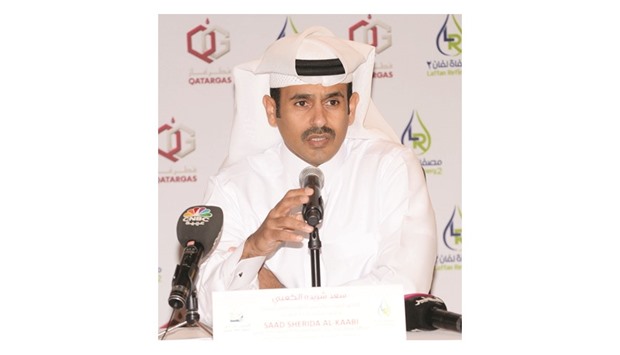A pipeline and associated facilities to supply jet fuel to the Hamad International Airport (HIA) from Ras Laffan would be completed “probably next year,” said Qatar Petroleum president and CEO Saad Sherida al-Kaabi.
The engineering, procurement, installation and commissioning (EPIC) contract to build a 24-inch pipeline and associated facilities that will be used to transport the jet fuel had already been awarded to a joint venture of Consolidated Contractors Group and Teyseer Contracting Company, al-Kaabi told Gulf Times in Doha yesterday.
“The project is on the way,” he said.
Laffan Refinery 2 (LR2), which was inaugurated by HH the Emir Sheikh Tamim bin Hamad al-Thani yesterday, produces naphtha, kerosene-type jet fuel (kerojet), diesel, propane and butane.
Kerojet powers jet aircraft. Kerosene, which is commonly used as a heating fuel, is hydro-treated to remove sulphur and produce a final product, Jet A1, considered a high-quality aviation turbine fuel.
Asked how much of the LR2 jet fuel would be consumed locally, al-Kaabi said, “We are not sure what the demand would be…how much of the LR2 products will be required internally in the country. As far as kerojet is concerned, it depends on how many jets Qatar Airways buys and how many other aircraft fly in and out of Hamad International Airport.”
But al-Kaabi affirmed that “we will be capable of meeting the local demand; the rest will go as exports.”
Earlier, QP had said the pipeline project would ensure that the long-term demand of Jet A1 supply to the HIA will be met beyond 2030, with the option of Jet A1 fuel availability from two distinct and separate sources: Ras Laffan and Mesaieed.
Al-Kaabi described the project as an important contribution to the diversification of Qatar’s economy and in support of the country’s aviation sector.
He said “the project is a testament to QP’s commitment to ensure the optimal utilisation of our natural resources by creating value-added products, and to secure energy supplies for the local and international markets.”
The project is made up of a number of components including a dedicated 24-inch pipeline from Ras Laffan to Doha; four Jet A1 tanks (53,000 cubic metres each); booster and mainline pumps, and power and firefighting systems.
When commissioned, this project will be capable of supplying all of the jet fuel demand of the HIA until 2030.
The project’s jet fuel will primarily come from Laffan Refineries 1 and 2, in addition to products from Pearl GTL, the world’s largest gas-to-liquids plant and one of the world’s largest and most complex energy projects ever commissioned. Page 2
Qatar and its shareholders, but also adheres
Laffan Refinery 2 not only creates value for Qatar and its shareholders, but also adheres to the highest environmental standards through low gas emissions; zero flaring during normal operation, and zero waste water discharge to the sea.
In addition, LR2 includes a waste water recycling facility, which treats industrial water from Laffan Refinery 1 and Laffan Refinery 2.
The recycled water is then re-used as boiler feed water and cooling water, thereby reducing water consumption and eliminating the discharge of treated industrial water.
Qatargas said by locally producing keroject and diesel, LR1 and LR2 are able to minimise the environmental footprint of both transportation and import of these products.
Like LR1, all products from LR2 will be hydro-treated to reduce its sulphur content, meeting the most stringent environmental and fuel quality standards. Products from LR1 and LR2, which include diesel and LPG (propane and butane), are globally marketable and highly valued as environmentally-friendly fuels due to their low sulphur content. The diesel produced by LR1 and LR2 meets the Euro-V fuel specification and is classified as ultra-low sulphur diesel.
Qatargas chief executive officer Sheikh Khalid bin Khalifa al-Thani said,“Qatargas has a distinguished track record for constructing and managing innovative facilities such as Laffan Refinery 2. This new refinery is a clear demonstration of Qatargas’ ability to manage and operate our resources safely, efficiently and reliably, and further strengthens our reputation for value creation and operational excellence. At Qatargas, we are proud of the trust bestowed upon us to enhance Qatar’s leadership position in the energy sector.”

Al-Kaabi addressing a media event at the Qatar National Convention Centre yesterday. PICTURE: Shaji Kayamkulam

